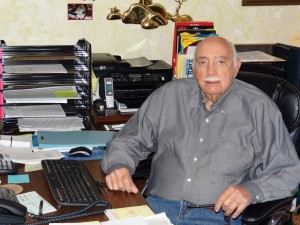The office isn’t easy to find. It’s listed as Suite 204 on the ground floor directory, but none of the doors along the hallway lists a Suite 204. Finally, another tenant gives directions to go to the end of the hall (which appears to be a dead end), turn right, and look in the door around the corner. Sure enough, there is the one-room Suite 204 and tenant: Carl Harman with Satanta Oil Co.
When the rest of the country pictures an oil company, it’s the large ones such as ExxonMobil or Oxy they envision. Not the one-man or five- or 10-person independent operators like Harman and others in the Permian Basin. These small operators don’t make the discoveries for which the large independents or majors are noted. Instead, they log small discoveries and, in the case of Harman, keep stripper wells going to add a significant amount to the country’s daily oil production.
Government regulations involving filing paperwork with the state Railroad Commission and Texas Commission on Environmental Quality, coupled with copings with critters such as a lizard or a chicken, can hamper what these small operators can accomplish. Some operators have decided the regulations and paperwork were piling too high and have pulled out of that side of the business.
Steve Castle with Cowboys Resources Corp. in Midland is among the group that decided the work wasn’t worth the effort. He quit operating and turned to the non-operating and investment side.
“A lot of small operators are getting out of the business,” said Castle, who left three years ago. “I work in the non-op side now. I partner with someone else. Their name is on the fence. I take small pieces of a lot of deals or I have someone else contract to operate it.”
If Castle hires someone to operate the project, he also wants the operator to participate financially. “What I found is if the operator doesn’t own a piece of it, there’s no incentive to make sure the bills get paid. I want them to have some skin in the game.”
Government regulations, both state and federal, are the major reasons that Castle left the operating business. “Large companies like ExxonMobil have regulatory people on staff who handle that side of the business. It’s not a big part of their budget. Small folks have to outsource it.”
One small operator who outsources some of the work is Bill Graham with Incline Energy in Midland. Even though he employs one staff person full-time to handle government requirements and paperwork, Graham still hires an outside consulting firm to deal with specialized needs. 
“In 2011, I spent $160,000 on consulting fees. Last year, I spent $150,000,” Graham said. Looking at his company’s income and expenditures, Graham said he calculated the percentage of return on investment and discovered “we made more money when oil was $24/barrel.”
They must meet reporting requirements by the RRC, the TCEQ, and General Land Office along with filing ad valorem taxes, payroll taxes, and Environmental Protection Agency papers. In the current drilling boom, Graham pointed out various services are also rising in price.
“Let’s say a major company drilling a well north of Midland on Sunday night needs a well servicing person to come out. The person they call says he’ll only come out if they pay him $200 an hour. The company agrees. That guy goes to the coffee shop the next week and says he got $200 an hour, so everyone else wants to charge $200 an hour. The cost of operating has gone up with the price of crude oil.”
Meanwhile, Graham is planning to spend another $150,000 this year on consulting services while anticipating additional regulations from the federal government. “I’m waiting for the next shoe to fall. The federal government already is looking at hydraulic fracturing and horizontal drilling. If they regulate hydraulic fracturing, the price of oil will go up and the supply will go down. The federal government can force the price of oil to go up by reducing the rig count” through additional regulations.
Large independents and majors can absorb additional fees and charges, but small operators say those costs are adding a large chunk to operating expenses. Graham said the RRC in January 2012 added a surcharge of 150 percent to the drilling permit fee.
“If a drilling permit would cost you $400, the surcharge added to it is $600. That makes the cost for a drilling permit to be $1,000. Big companies say it’s the cost of doing business,” he said. “But I don’t drill a $6 million well. I drill a $600,000 well.”
He also has watched lease costs skyrocket in the sought-after areas. “That hurts the small operator. The big companies are paying up to $12,000 an acre for leases. I buy leases for $500 an acre. These big prices can be paid by the large companies like Chesapeake and Oxy because it’s not their money. It’s the stockholders’ money.”
And one additional thought from Graham: “We haven’t looked yet at what’s going to happen to our company with Obamacare.”
Castle mentioned regulations in other states have influenced small operators such as himself to switch to another side of the business. “New Mexico is getting better but Colorado’s regulations are terrible,” he said.
Wally Drangmeister, director of communications for the New Mexico Oil and Gas Association, said his organization is working on changes to the Pit Rule. “Small operators are less likely to have a closed loop system. It’s all but impossible for them. We’re asking for relief for them to be able to use lined pits.”
The process to change this regulation was started in Fall 2011 and the proposed change has had a hearing before the Oil Conservation Commission. “The jury is still out,” Drangmeister said. “We’re cautiously optimistic that we will get some relief.”
As for taxes, the NMOGA spokesman said the organization “has worked to keep the tax situation lower. There have been no significant tax changes.”
Carl Harman represents the typical operator of stripper wells. He has a one-man office and maintains 65 to 70 wells that produce 10 or fewer barrels of oil per day.
Harman doesn’t do much drilling but focuses instead on working over the wells to keep them producing. “Our niche is personal contact with a well. We take care of the business and it is hands on.” He also operates a well servicing unit with a workover and pulling unit.
“If we get three barrels a day, we call it a good well,” Harman said with a laugh. “If it’s 10 barrels, that’s cause for celebration.”
What he’s not celebrating, however, is the amount of paperwork he must do to meet state and federal reporting requirements.
With a career as a production engineer working for different majors in other states and overseas, Harman detoured from the petroleum industry superhighway to carve his own path as a small independent operator. He started Satanta Oil Co. 28 years ago in Midland.
While Harman jokes about the number of barrels of oil per day he gets from these wells, the National Stripper Well Association points out the importance of this segment of the industry.
“For every $1 million directly generated by stripper well production, more than $2 million in economic activity is generated elsewhere. Each additional $1 million of stripper well production employs 10 workers directly and indirectly, with some producers employing as many as 15 workers.”
In 2008, the NSWA reported, stripper wells produced almost 262 million barrels of oil, which was about 20 percent of the total U.S. production. Texas leads the nation with more than 132,000 stripper oil wells and more than 46,000 marginally-producing natural gas wells.
Wikipedia also points out that from 1994 to 2006 about 177,000 marginal wells were plugged and abandoned, representing a number equal to 42 percent of all operating wells in 2006. This cost the United States more than $3.8 billion in lost oil revenue at the U.S. Energy Information Administration’s 2004 average world oil price.
Not all those wells were plugged properly and in Texas the Railroad Commission instituted rules for abandoning a well. “All the regulations the RRC has imposed in the last two years regarding temporary abandoned wells affect us 100 percent. They affect us [as a small operator] more than anyone else. We are forced to do more and more paperwork. I joke that if it weren’t for the Railroad Commission, I wouldn’t get any mail. I get four to five forms every week to fill out.
“The problem I run into is getting things done to meet the requirements,” Harman said.
Even though he isn’t fond of the paperwork, the operator said he understands why the RRC has implemented such a long list of requirements. “The rules had to be made to prevent people from walking away from abandoned wells without plugging them. These regulations are trying to solve a problem that exists.”
Filling out the form isn’t the only part of the procedure. The operators must submit a bond. “We have an escrow account with the RRC to cover the cost of plugging. If an operator goes out of business and his wells are not in compliance, the operator loses his bond. To receive our P-5 operating permit, I must have a letter of credit.”
The RRC isn’t the only agency with a long list of forms for Harman to complete. The University Lands office adds its share to the stack. In the case of both agencies, Harman realizes the state offices are overloaded with work and do not have enough employees to handle it. However, he would like to see the agencies ask people in the petroleum industry how they would want the forms changed. “The University Lands forms look like they’ve been generated by in-house accountants,” he half-joked.
Some cooperation between the agencies and industry in reducing the paperwork would be mutually beneficial, he said. In an industry expected to continue growing, the paperwork load and fees aren’t going to decrease. “This boom is fueled by technology and there is no end in sight of where it is going. However, the government can slow it down” by imposing more regulations and eliminating the depletion allowance, Harman said.
Despite the paperwork requirements, the operator of stripper wells has no intention of quitting. “Being an independent has been fun. I love this business. It’s my hobby.”










